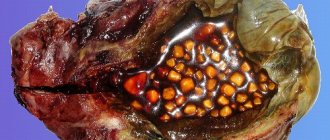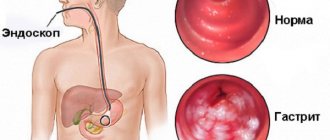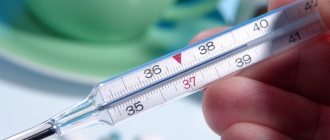The inflammatory process in the body is always accompanied by elevated body temperature. Gastritis is no exception. In the chronic course of the disease, the temperature is normal, but in the acute form it may increase. The appearance of heat, chills or fever is associated with the nature of gastritis and the distinctive features of the body.
Causes of the disease
Temperature during gastritis is a common occurrence in acute gastritis. The main causes and conditions for the occurrence of stomach disease are:
- improper diet;
- excessive consumption of alcohol and tobacco products;
- irritability, stress instability;
- ingress of poisonous or chemical substances;
- eating spicy, smoked, too hot food;
- the presence of bacteria and pathogenic microbes in the body;
- allergic form of gastritis;
- infection;
- intoxication;
- internal bleeding.
The appearance of a high temperature is not a serious pathology, but indicates the presence of an acute form of the inflammatory process. An increase in values greater than 39° indicates the penetration of bacterial infections into the body (Helicobacter pylori, staphylococcus, streptococcus) or intoxication with harmful substances (salts, acids, toxic chemicals) in fibrinous and corrosive forms of gastritis.

Body temperature also increases with food poisoning, overeating, or an allergic reaction to foods. High rates may indicate the development of a stomach ulcer or internal bleeding in the presence of cicatricial deformities and erosions. A common condition for the occurrence of fever is inflammation of the organs involved in the digestive process: pancreas, liver, intestines, gall bladder.
Causes for the chronic type
In the chronic form of gastritis, there cannot be a high temperature. Even an attack as a result of non-compliance with contraindications (drinking alcohol, smoking, eating unhealthy food) is not the cause of its occurrence. Indicators over 37° indicate diseases not associated with the inflammatory process in the stomach, for example, infection, colds, or viruses. If the temperature rises, then it is a harbinger of an exacerbation of the disease or complications associated with the digestive organs.
Causes in children
In childhood, an acute form of the disease, accompanied by high temperatures, is a consequence of emotional and physical stress in educational institutions, as well as poor nutrition, based on snacks and dry food. In a child, indicators that differ from the norm may be the reason for consuming foods that are not intended for a child’s diet.

Can there be a low temperature with gastritis?
Typically, patients are afraid of increased body temperature with gastritis, although there are often cases when it drops below normal levels. Because of this condition, you should worry much more. If you see values of 36-36.4 °C on the thermometer, then this indicates general fatigue and loss of strength. The body simply refuses to fight, its immunity is weakened. A person “catches” any viruses, bacteria, he often gets sick, and takes a long time to recover. In this case, it is necessary to look for the root cause of this condition, and not to treat the manifestations.
Similar symptoms are often observed with chronic gastritis. If the patient does not adhere to a diet or does not follow the recommendations of the attending physician, his body gets used to living in conditions of constant stress and chronic inflammatory process. The patient no longer even feels pain. Up to a certain point, he is sure that everything is fine, but the body’s resources are not unlimited, so at one point he gives up. Usually, at first the temperature rarely rises, and then it just as suddenly drops and remains at a low level.

Symptoms
Gastritis with the presence of temperature symbolizes a severe degree of inflammation of the gastric mucosa. In addition to high rates, the acute form is accompanied by certain symptoms.
General symptoms
An increase in temperature with gastritis of more than 37°C has additional symptomatic signs:
- cramps in the stomach;
- severe abdominal pain on palpation;
- the presence of nausea, vomit, the black color of which indicates internal bleeding;
- loss of appetite;
- noticeable weight loss;
- headache;
- malaise, weakness;
- dehydration;
- white coating on the tongue;
- heartburn, belching with increased acidity in the stomach;
- bloating, increased gas formation, flatulence;
- loose stool.
Symptoms in children
A high temperature may be accompanied by other signs of an acute inflammatory process of the mucous membrane. Over a short period of time, the child’s general well-being deteriorates, pain, stomach cramps, and the urge to vomit appear. Gastritis, formed as a result of infection, is characterized by mucus secretion and loose stools.
Symptoms in pregnant women
Expectant mothers with gastritis may experience increased temperature, heartburn, nausea, and periodic pain syndromes in the stomach. These symptoms are accompanied by weakness and general malaise.
Symptoms of exacerbation
If a high temperature with a stomach ulcer is caused by an exacerbation of the disease, it stays within 38-39 degrees and is subfebrile in nature - it persists for a long time. The symptom is accompanied by sharp pain in the upper abdomen, the appearance of mucus and blood in the stool. Complications are typical for late stages of the disease. They can be triggered by bad habits, stress, poor diet, and alcohol intake.
A temperature of 37 with a stomach ulcer occurs at the initial stage of development of the disease. It indicates the appearance of internal bleeding. In this case, the mercury column does not exceed 37.5. A characteristic sign of the onset of bleeding is vomiting, resembling coffee grounds.
Diagnostics
To identify the causes of increased body temperature, diagnostics are prescribed. A common condition for the occurrence is an acute form of gastritis. To confirm the diagnosis and exclude a possible cold or gastrointestinal infection, examinations are carried out:
- laboratory testing of blood, urine, feces;
- endoscopy;
- Ultrasound of the abdominal organs;
- radiography.
Biological material is collected for testing for the presence of infections and pathogens. A blood and urine test can reveal the existence of an inflammatory process, as well as disturbances in the functioning of the gastrointestinal tract. Endoscopy, X-rays and ultrasound examinations provide information about the presence of erosions, ulcers, and cicatricial deformities on the upper surface of the digestive organ.
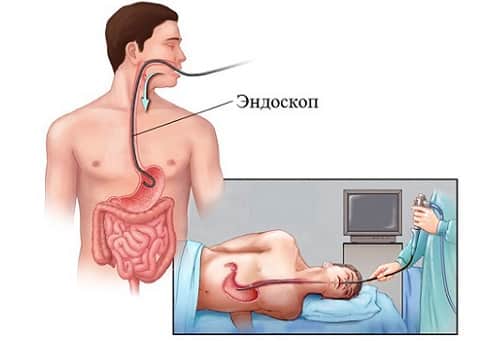
When the diagnosis of acute gastritis is confirmed, special treatment methods are prescribed. Identifying signs of infectious or cold diseases can bring down the temperature with antipyretics or antibiotics.
If the temperature doesn't drop
Cases when the temperature does not drop, but only rises, are rare, but such a possibility also exists. There may be several reasons for this:
- Incorrect diagnosis
- Simultaneous development of several ailments,
- Individual immunity to the proposed drugs.
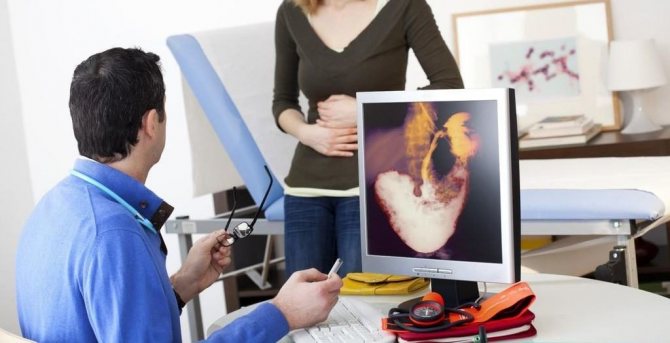
The doctor conducts the necessary examinations, making sure that gastritis has not yet turned into an ulcer, and that tumor processes are not developing in the gastrointestinal tract. When treating any illness, it is important to find its root cause. Then the treatment will be effective.
If the patient does not listen to the doctor’s recommendations and ignores his instructions, especially in matters of nutritional correction, then one should not expect a positive result. The temperature will not decrease because there is an uncontrolled, sluggish inflammatory process in the body. The more advanced the patient’s condition, the more difficult and lengthy the treatment will be. There is no need to take a disease such as gastritis lightly. From its consequences you can remain disabled or say goodbye to life altogether. Watch your health if you do not want this outcome.
Treatment options
Only a gastroenterologist can prescribe therapeutic treatment for adults and children. After tests and laboratory tests, the causes of the high temperature and an accurate diagnosis are established. To reduce indicators, you need to resort to proven folk remedies.
Medicines
In acute forms of gastritis, taking medications, such as antipyretics, is prohibited. Anti-inflammatory drugs may cause internal bleeding or damage to the upper surface of the stomach. Medicines are prescribed if the temperature rises above 38° and lasts for a long time. Then it is possible to take antibiotics, use droppers along with enveloping agents to avoid complications.
ethnoscience
Effective ways to reduce high levels are to drink plenty of fluids. You can lower the temperature with:
- still mineral water;
- hot tea with honey;
- natural berry fruit drinks;
- warm milk, such as goat's milk.
You can brew tea from linden, cranberry or viburnum flowers. In no case should you use a drink with the addition of lemon, which is an additional irritant for the inflamed mucous membrane, to reduce the temperature. You can prepare an infusion from willow bark that effectively combats high temperatures at levels of hydrochloric acid that do not correspond to the norm.
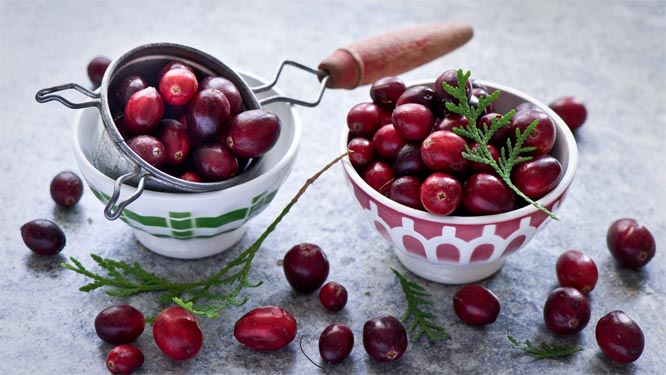
Berry-based tea is prepared by pouring hot water over the fruit, letting it sit and adding honey. Hot drinks are given after meals throughout the day.
Treatment of children
To reduce pain accompanied by elevated temperatures, you must follow a strict diet. Excluding harmful foods from the diet, drinking regimen, and taking antibacterial drugs will restore the damaged gastric mucosa. As an additional measure for treating gastritis, you can resort to gastric lavage.
Treatment of pregnant women
High temperature as a consequence of a severe form of inflammation of the gastric mucosa can negatively affect the well-being of the expectant mother and the intrauterine development of the fetus. To avoid serious pathologies, medications should not be used. Traditional methods are also not suitable for pregnant women, as they can cause food allergies in the fetus.
Only a specialist can prescribe the correct treatment as an alternative therapy. To prevent attacks of pain, you should follow a daily routine, eat right, rest, and not overexert yourself physically and emotionally.
Prevention
As preventive measures, you should follow a diet and lead a healthy lifestyle. To avoid exacerbation of the disease it is necessary:
- to refuse from bad habits;
- eat fresh fruits and vegetables;
- do not include fatty, salty, smoked, spicy foods in your diet;
- observe the rules of hygiene;
- avoid stressful situations;
- Get tested and examined regularly.
Following a diet and drinking regimen will relieve fever and prevent a possible attack of the disease.
An acute type of gastritis is a disease of the gastric mucosa, characterized by severe inflammation. Human health depends on the environment, ecology, diet, lifestyle and emotional state. Inflammation of the mucous membrane of the digestive organ is a disease that today occurs quite often in both adults and children.
The first sign of a malfunction of the body is temperature. High rates indicate the presence of an internal inflammatory process. Identification of the causes based on the results of the examination and established symptomatic signs will prevent attacks of the disease.
The information on our website is provided by qualified doctors and is for informational purposes only. Don't self-medicate! Be sure to consult a specialist!
Author: Rumyantsev V. G. Experience 34 years.
Gastroenterologist, professor, doctor of medical sciences. Prescribes diagnostics and carries out treatment. Expert of the group for the study of inflammatory diseases. Author of more than 300 scientific papers.
Fever with a stomach ulcer is an atypical manifestation of the disease. It indicates the presence of an inflammatory process in the body. Treatment is complicated by the fact that the list of medications allowed for this diagnosis is strictly limited.
Food poisoning
The most common cause of abdominal pain and fever in adults is food poisoning. It occurs due to the consumption of expired or low-quality products that contain pathogenic microorganisms.
Due to the entry of pathogenic microorganisms into the body and as a result of toxic damage by the products of their vital activity, the usual microflora of the stomach and intestines changes, and acute poisoning occurs.
In addition to intense pain and body temperature above 38 °C, the following clinical signs are present:
- Severe diarrhea.
- Nausea.
- Vomit.
- General weakness and other signs of intoxication of the body.
If you have food poisoning, it is very important to maintain fluid balance, that is, drink as much fluid as possible to avoid dehydration. Doctors also strongly recommend using absorbent drugs, and sometimes antidiarrheals are used.
It is very important in such situations, if the temperature reaches high values (over 38.5 ° C), to take an antipyretic. To relieve pain in the stomach, antispasmodics are taken. Otherwise, in case of acute poisoning, you need to consult a doctor or even call an ambulance.
